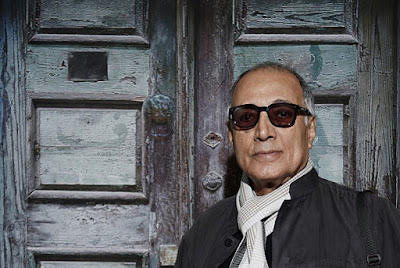The Iranian film-maker is showing a photographic series he’s worked on for 20 years at Toronto’s Aga Khan Museum
 |
| Abbas Kiarostami. Photo: Janet Kimber/Aga Khan Museum. Courtesy The Art Newspaper. |
Doors Without Keys, by the Iranian film-maker Abbas Kiarostami, is a maze-like installation of 50 photographs, all showing locked doors fr om buildings in Iran, Italy, France, and Morocco, printed life-size on canvas. The pictures, which have never been exhibited before, are now on view at the Aga Khan Museum in Toronto until 27 March 2016. The show, which is expected to travel, is co-curated by Peter Scarlet, the former director of the Tribeca and Abu Dhabi Film Festivals and Amirali Alibhai of the Aga Khan Museum. At the show’s opening in November, 76-year-old Kiraostami, one of Iran’s best-known artists, talked about the still photograph and the visual nuances of wood.
Did you take still photographs before you started making films?
It happened afterwards. I owe it to the 1979 Revolution, because it was very hard to make films. I had to go on producing images, so I started taking still pictures. It became a parallel activity to filmmaking. They interact. There’s a mutual influence.
In the contemporary art world, the moving image seems to be replacing everything. Why do you remain drawn to still photography?
I guess it’s a defense mechanism, but also kind of a protest against all this—in my view—unwelcome movement in images. Some of my latest works are experimental films that last four or five minutes. But each still image can last four or five minutes. If an image is worth seeing, it takes concentration and contemplation. The reason why there is so much movement is probably that nothing is worth being seen in what is actually shown. This is my way of protesting against that.
Look at how people relate to the pictures shown here. They choose the best position, and they stand still in front of it, and they stare at it. This is the kind of opportunity that is given less and less in contemporary art.
These are pictures of objects that, as they decay, like architecture, retain a structural beauty and take on what seem like infinite nuances.
 |
| Abbas Kiarostami, Doors Without Keys. Photo: Janet Kimber/Aga Khan Museum. Courtesy The Art Newspaper. |
I didn’t start with doors, I started with walls, and then walls took me to windows, and windows to doors, but I also have trees, and snow. I have 11 collections of motifs. The features that I’ve been attracted to—in doors, as well as in walls—is life, aging, the beauty of age.
In the 20 years in which I worked, the quality of the doors got less and less interesting, but my camera was getting better and better. So I had to find this balance between good quality pictures and doors that were worth seeing.
I am absolutely sure that none of the doors that you see here are in service. In Italy, where I went scouting locations for my film, Certified Copy, I could not find any of the doors that I had seen before.
Did you do anything to the doors before photographing them? Was “makeup” applied?
If you consider cleansing to be makeup, I must confess that I did some cleansing to take off the dust of years.
What is it about the wood on these doors that draws in the eye, even in decay?
All I can tell you is that when I feel really depressed, the only thing that does me good is to go back to one of my favorite activities. I was trained as a carpenter, and I love working with wood. Soon in Tehran there will be the opening of my works—gigantic, twice as big as the pictures that you see here. I framed them myself, I made all the wooden frames.
 |
| Abbas Kiarostami, Doors Without Keys. Photo: Janet Kimber/Aga Khan Museum. Courtesy The Art Newspaper. |

No comments:
Post a Comment